Agile, stealthy and ferocious hunters: an identification guide to seven incredible native felines throughout Chile and South America.
Almost a third of the feline species in the world live in South America, seven of which can be found throughout Chile and in some of the varied habitats of neighboring Argentina and Peru. We spoke with leading experts to learn some of the most surprising facts about these mammals; the main threats faced by each species as well as the surprising similarities and differences between them, necessary for their correct identification.
Possessing excellent senses, an agile and flexible body, sharp claws and a superlative sense of smell – felines are a truly exceptional species of the animal kingdom.
In the classification system of organisms (also known as taxonomy), the large Felidae family (also called felids and, commonly but imprecisely referred to as cats) has two living subfamilies: Pantherinae with its two to three genuses including infamous species such as the tiger (Panthera tigris) and the lion (Panthera leo); and Felinae, which is made up of more than 10 genuses and about 30 species. The Felinae subfamily is largely composed of small and medium-sized cats, but also includes species such as the puma (Puma concolor) and the cheetah (Acinonyx jubatus).
It is within this subfamily Felinae that the seven spectacular species of cats native to Chile and other parts of South America are found: the puma, the Andean cat (Leopardus jacobita), the Geoffroy’s cat (Leopardus geoffroyi) and the güiña (Leopardus guigna) as well as the colocolo cats. Until recently the nomenclature Leopardus colocola (colocolo cat) was understood to include several sub species, but recent studies have revealed that these are indeed distinct species, differentiated now as the Pampas cat (Leopardus garleppi), the colocolo cat and the Southern pampas cat (Leopardus pajeros) amongst others.
“Recently a controversial taxonomic study was carried out on the colocolo cats,” Nicolás Lagos explains. “Its findings provided evidence that the five sub species of Leopardus colocolo are actually five unique species, three of which are found in Chile, increasing the nation´s cat species from five to seven.” Lagos is a specialist in Chilean wild cats. He currently serves as the Coordinator for the Human-Puma Coexistence Program in Patagonia for the NGO Panthera, and also co-coordinates the Andean Cat Alliance NGO.
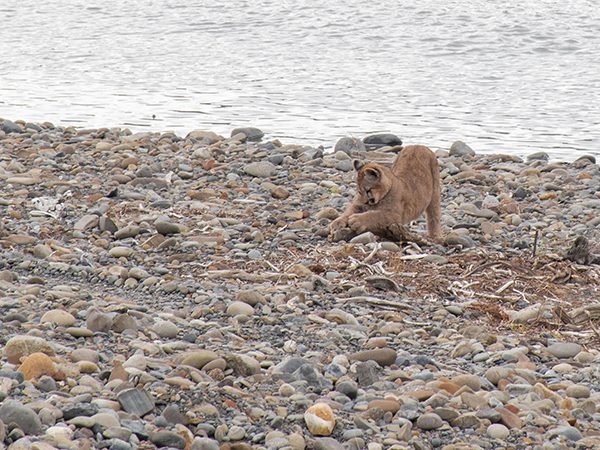
Wonderful wild cats with varying degrees of separation
Cats, with their solitary behaviours, are in danger around the world. Their main threat in Chile and the wider South American region is hunting; or hunting of the animals they predate on. Others include habitat loss, forest fires, attacks by feral dogs, diseases transmitted by domesticated animals and climate change.
“Hunting, fortunately, is increasingly declining,” explains Agustín Iriarte. “The most affected species continue to be the güiña and the puma. Climate change will continue to be a threat in central Chile, heralding drought, increased temperatures and a decrease in prey.” Iriarte is an ecologist and cat expert. He is also the General Manager of Flora & Fauna Environmental Consultancy Limited and co-founder of the Andean Cat Alliance, as well as the author of more than 20 books in the environmental sphere.
The rich data that have been researched and subsequently shared by organizations such as the Andean Cat Alliance or Panthera are spearheading greater understanding of these animals and helping guide their protection measures.
“Big cats are iconic,” says Tim Connolly. “We are guilty of thinking of them as unpredictable animals exhibiting a certain fixed-range of behaviors. However, we are coming to learn that they have an ability to adapt and express very different habits from those we have come to expect.” Connolly is an independent guide operating in Chile´s Torres del Paine National Park, and is an expert in flora, fauna, ecology and ethology.
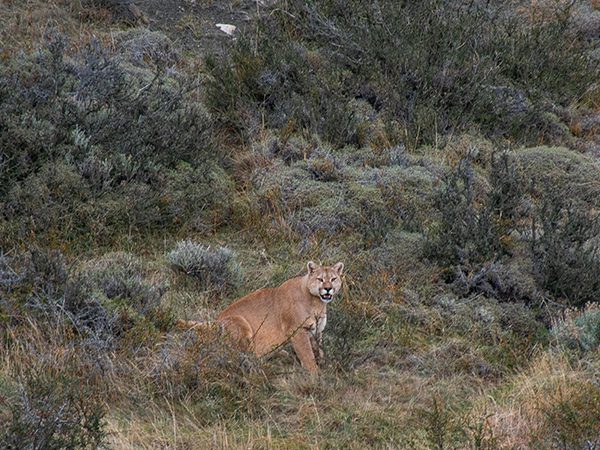
Puma (Puma concolor)
The puma is the largest of Chile´s cats. It can be found in forests, mountainous areas and pampas, from Canada to the Strait of Magellan in Patagonia.
Its body can measure up to 180 cm in length with its tail an additional 90 cm long. Males are usually larger than females. Its coat is a uniform brown, grayish or reddish color, with the inside of its legs, chest and belly a lighter shade of these colors. Puma cubs initially have fur with dark spots and stripes on their tails up to six months old.
Chilean Patagonia, specifically Torres del Paine National Park, bears the highest density of pumas globally. Their diet in this part of the world consists of guanacos (Lama guanicoe), hares, birds and small rodents.
Its conservation status is Least Concern (IUCN).
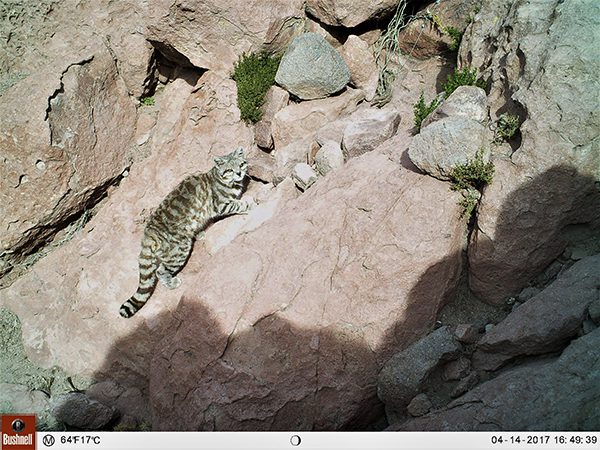
Andean mountain cat (Leopardus jacobita)
This cat is present in the Andes mountains of Argentina, Chile, Bolivia and Peru, up to 5000 meters above sea level. It inhabits arid and rocky areas near water sources, open grasslands, humid forests and steppes.
The Andean mountain cat can measure up to 85 cm long with its tail measuring an additional 50 cm. It has long, soft and mottled fur. Its coat is an opaque gray with a white under-belly. Its hairy tail has nine dark rings.
The Andean mountain cat preys principally on vizcacha (Lagidium viscacia) but also feeds on small and medium-sized rodents, birds and reptiles.
“It is a super rare species to find in the wild, making it difficult to study,” says Lagos. “However,” he adds, “considerable progress has been made over the last few years. Its main threats, at least here in Chile, are large-scale human activities, such as mining in the central-northern area.”
Its conservation status is Endangered (IUCN).
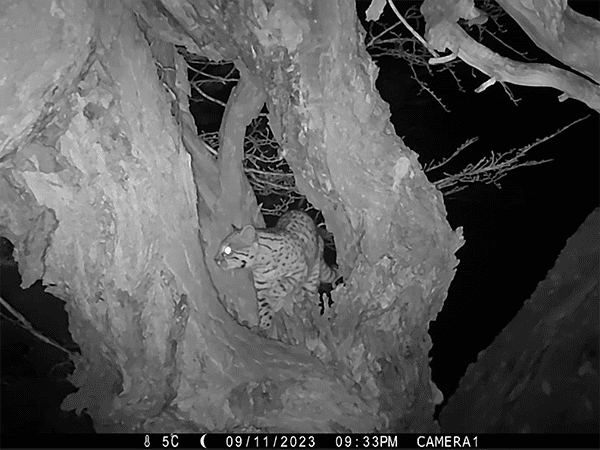
Geoffroy’s cat (Leopardus geoffroyi)
Geoffroy’s cat or the South American wildcat is one of the most abundant cats in South America, found in mountainous areas, forests, jungles, pampas and wetland areas of Bolivia, Paraguay, Brazil, Argentina and Uruguay. It also has a patchwork of habitat areas in southern Chile, in the regions of Aysén, Magallanes, and Araucanía.
The Geoffroy’s cat is a small animal, measuring 60 cm with a tail up to 30 cm in length. Its fur varies in color from a yellowish-brown in the north to a grayish color in the south. Some melanistic or black-pigmented specimens also exist.
Its conservation status is Least Concern (IUCN).
Güiña (Leopardus guigna)
The Güiña is the smallest of the South American wild cats. It lives in humid and temperate forests, scrublands, coastal areas and mountain areas up to 2500m of altitude. It is found throughout Argentina. Its dristribution in Chile ranges from Coquimbo in the north through the island of Chiloé and the archipelago of Guaitecas, to the Patagonian region of Aysén.
Güiña measure around 64 cm in length with a tail up to 25 cm. Its coat can be a brown or yellowish-brown color with dark circular spots. Its relatively short tail has dark rings. Incidences of melanism in the species are high.
The cat can be active both day and night, and is an agile tree climber. Its diet consists of small mammals, wild birds and poultry.
Its conservation status is Vulnerable (IUCN).
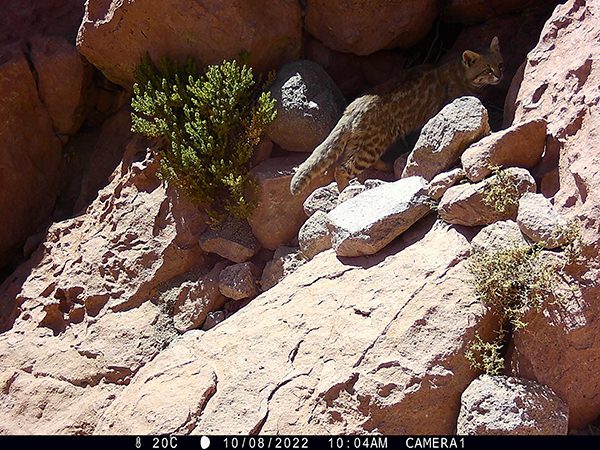
The colocolo cats
Pampas cat (Leopardus garleppi)
The pampas cat or desert cat lives in semi-arid environments, highland steppe, foothills as well as forested areas including jungle. It is distributed throughout Ecuador, Peru, Bolivia, northern Argentina and northern Chile.
It measures up to 80 cm with a tail of almost 30 cm in length and it is the smallest of the colocolo cats. Its fur is gray and it has small spots or rosettes of brown coloration with dark borders. It has a black-ringed tail.
This species and Leopardus colocola differ from the Andean mountain cat in that their noses are pink and not black. They also have more pronounced dark brown bands on their front legs.
Its conservation status is Near Threatened (IUCN).
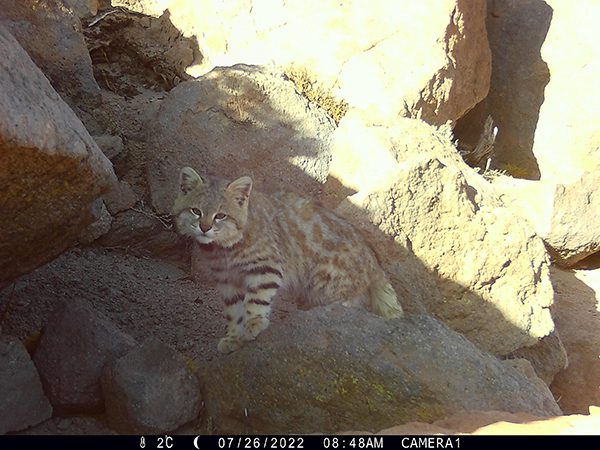
Colocolo cat (Leopardus colocola)
The colocolo cat is found in forested and rocky scrubland, as well as mountainous areas. It is endemic to a 600mile range throughout central Chile from Coquimbo in the north, to Concepción in the south.
It is slightly larger than the domestic cat and is similiarly long-haired. Its appearance is similar to the Leopardus garleppi.
Its conservation status is Near Threatened (IUCN).
Southern pampas cat (Leopardus pajeros)
The Southern pampas cat is the largest of all the colocolo cats. It is widely distributed throughout Argentinean Patagonia and parts of Chile, specifically in the Aysén and Magallanes regions. Its habitats include mountainous and steppe areas.
It is commonly confused with Geoffroy’s cat because both are spotted and are of similar size, however Geoffroy’s cat is grayer and the pampas cat is a lighter brown color.
Its conservation status is Near Threatened (IUCN).
We would like to thank Agustín Iriarte and his book Guide to the Mammals of Chile (Second Edition, 2021)

